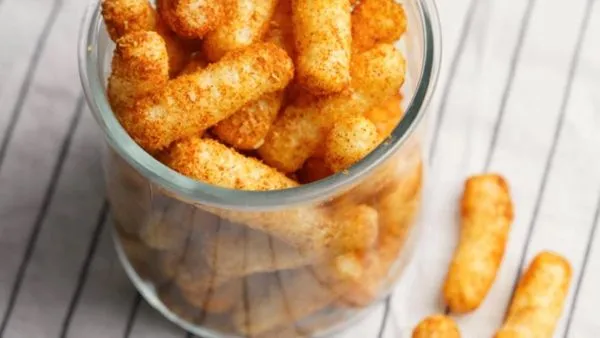Corn Puffs - More than just pastime?
Many parents and children love them: the chubby, puffy corn puffs that are light as air and perfect to have in the diaper bag and give to the baby. But how good are they really? And what do they contain?
Read time: 3 m
Verified by Sara Ask
Licensed dietitian
Most corn puffs available on the market contain corn (of course!) and possibly a little sunflower or rapeseed oil. This means they primarily consist of carbohydrates but also contain some protein and fat. 100 grams of corn puffs provide roughly the same amount of energy as 100 grams of stovetop-popped popcorn. However, per corn puff, they don't provide much energy or nutrition due to their lightweight. At the same time, it can be enough to promote tooth decay, so it's advisable not to let the child snack on corn puffs.
Do corn puffs turn into sugar?
A recurring criticism of corn puffs is that due to their high carbohydrate content, they convert into sugar in the body. That doesn't sound very good—as if you might as well feed your baby sugar cubes, right? However, the point of carbohydrates is for them to convert into sugar in the body. Carbohydrates consist of chains of sugar molecules that break down in the gastrointestinal tract to be absorbed and used as energy. Sugar is the brain's and muscles' primary fuel. So, the breakdown into sugar itself isn't bad. The crucial aspect is that the carbohydrates one consumes also provide other nutrients, such as vitamins and minerals. This is where corn puffs fall short, even when considering the content per 100 grams. They don't come close to comparing with foods like fruits, vegetables, bread, porridge, and yogurt. Therefore, corn puffs should not replace any snack, but only serve as an occasional addition to nibble on.
Good chewing practice
One advantage of corn puffs is their consistency, which is suitable for practicing chewing. For children who struggle with handling different textures, corn puffs can be an excellent aid along the way: easy to grasp, bring to the mouth, and practice oral motor skills with. Corn puffs are crispy initially and then melt in the mouth, making them perfect for this exercise. If you have a child who is growing a bit slowly, you can try dipping the corn puffs in something to increase their nutritional content, such as a bit of hummus or aioli. Alternatively, you can spread some liver pâté, vegetarian pâté, or cream cheese on them.
Corn puffs can also be used to adapt the family's food for the baby. For example, if a clear soup is served that the baby finds difficult to eat, you can easily thicken the baby's portion with one or two corn puffs. Voila, the soup becomes easier to eat!
Don't give too easily One risk with corn puffs is that they are so easy to grab and give to the baby that it becomes a reflex response at the slightest whimper. However, often there may be something entirely different that the child needs: a little attention, something fun to play with, or a fresh diaper, for example. In other words, feel free to give corn puffs now and then, but not as a substitute for other needs.
Verified by Sara Ask
Licensed dietitian
Hundreds of related articles, podcasts & more waiting for you in the Preggers app.
Download Preggers today.



